

What is marketing attribution? I think we can all agree that we live in a dynamic, omnichannel world where customers interact with brands and companies on many different levels and via various channels. In May 2021, Upland, an omnichannel marketing platform, conducted research revealing that, on average, customers interact with brands across a mix of 20 channels.
Marketing attribution is the process of determining which interactions influence a customer to purchase from one’s brand. With this information, marketers can identify which campaigns or channels drive the most conversions; affiliate networks and other organizations that help promote brands can determine if they should receive credit for a conversion, or a sale. So there’s a lot at stake — who gets paid, and insights into what’s worth investment and what isn’t.
This fact causes a headache in many marketing teams. In the same study, 64% of marketers said their team lacks the knowledge or skills to effectively analyze and segment customer data. Granted, the omnichannel world is difficult to harness. However, while it’s not easy, it’s not impossible. And that’s where marketing attribution steps into the game.
To make the scenario more interesting, Google Chrome, the world’s most popular web browser, is getting ready to deprecate third party cookies, joining all of the other major browsers. Various attribution formulae to which we’ve grown accustomed may soon become unavailable as granularity is potentially removed from the table. So that’s something to keep in mind. A good place to start is to look at the various types of attribution formulae.
We can talk about at least four different approaches to marketing attribution. They can be divided into two groups:
- Single-source marketing attribution: You indicate and give all the credit to just one touchpoint in this approach. In other words, you assume that there is just one stage in the customer journey that defines whether someone will or won’t become a customer.
- Multi-source marketing attribution: Here, you acknowledge that there are several touchpoints along the way that can influence someone’s decision to place an order or to reach your company.
Within these two groups, we have several models. Let’s take a look at them:
In this article we will cover:
What is first-touch attribution?
We start with the most straightforward model that belongs to the single-source group. In the first-touch attribution model, you assume that the first touchpoint is the most important one. You give all the credit to the very first interaction that happened between you and your customer. In the B2B world, it can be downloading an e-book or reading a blog post. In the B2C world, it can be viewing an ad or a social media post that your customer’s friend liked.
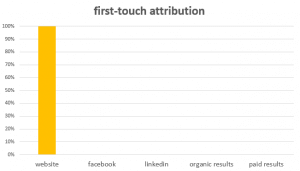
On the upside, this approach is really easy to implement. On the downside, it doesn’t take into consideration any other interactions. Therefore it can be significantly biased.
What is last-touch attribution?
This time, we focus our attention exclusively on the last interaction that happened before placing an order. However, you have to face the same problem as before–the last-touch attribution model totally neglects everything that happened before that last contact.
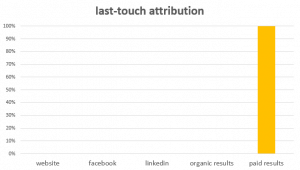
It should be noted that Google announced in September that it will no longer use last-click attribution as the default conversion model in Google Ads, its buy-side ad network, the company announced in a recent blog post.
The change will mean that, going forward, the default attribution method for any conversion touchpoint – a new product purchase page, app install campaign, display ad landing page – will fall into what Google calls “data-driven attribution,” its algorithmic solution that assigns credit to different impressions over time.
Some time ago, when the number of channels that customers used to interact with your brand was much lower, these two approaches were sufficient. Today, though, there’s so much going on in between, there was a need to introduce some more complex models, fitting our today’s dynamic world. And that’s where we turn our attention to the multi-source marketing attribution techniques.
What is multi-source (or multi-touch) attribution (MTA)?
This model is far more comprehensive, primarily because it takes each contributing channel into account. We could say that here, our goal is to understand how a series of both online and offline activities lead to a conversion. Not one channel or touchpoint is favored; attribution is always given to multiple touchpoints.
Linear Attribution
Each touchpoint is equally important.
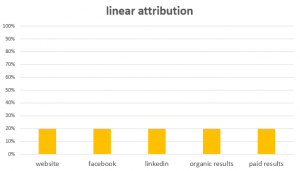
Time-Decay Attribution
The closer the given touchpoint is to the conversion, the more important the role it plays.
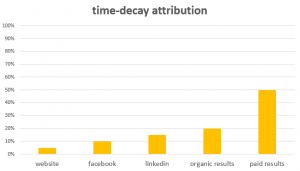
U-Shaped Attribution
This model gives most of the credit to the first and last touchpoints.
W-Shaped Attribution
The credit is divided between the first, middle, and last touchpoints.
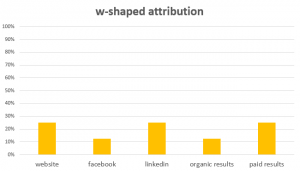
Custom Attribution
Here, you assign your own importance (based on your knowledge and experience) to any of these touchpoints.
And lastly, we have something called:
Weighted Multi-Source Attribution
In this model, you acknowledge all of the touchpoints and interactions that happened throughout the entire customer journey, and you also assign a specific weight to those touchpoints that had the greatest impact on the end result, i.e., the conversion.
Each attribution formula works well in specific conditions. The best thing you can do is test diverse marketing attribution models and stick to the one that proves to be effective in your case.
And if you want to find out more about marketing attribution, we invite you to check out the recording of our webinar on “The future of attribution in a third party cookieless world.”
- Webinar Recording Link
- Passcode: E$27Zhq+
During the webinar, we discussed the present and future of attribution for mobile games, mobile apps, e-commerce, and connected TV with the end of third-party cookies in the background. The panelists included Kristina Prokop – CEO & Co-founder of Eyeota; Stephanie Gutnik – Global Head of DOOH at Yahoo; David Pollet – Chief Revenue Officer at Cross Screen Media; Kurt Kendall – Chief Analytics Officer at Publishers Clearing House; and Kevin Mullen – Chief Product & Strategy Officer at Roqad.
If you’d like to discuss attribution with one of our experts, feel free to contact us.